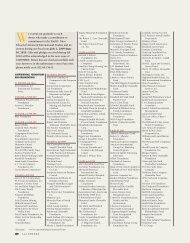Download Current Issue - SAIS
Download Current Issue - SAIS
Download Current Issue - SAIS
Create successful ePaper yourself
Turn your PDF publications into a flip-book with our unique Google optimized e-Paper software.
of less than two hectares (about five<br />
acres), supporting some 2 billion<br />
people. But the 0.5 percent of farms<br />
that exceed 100 hectares capture<br />
a disproportionate share of global<br />
farm income, enjoy privileged access<br />
to policymakers and—particularly<br />
in developed countries—receive<br />
generous subsidies. Further, buying<br />
power is increasingly concentrated<br />
in the hands of agribusiness and<br />
other powerful corporate actors that<br />
generally prefer to deal with larger<br />
operators who can deliver sizable<br />
lots of produce.<br />
n “Land grabs.” Seeking to ensure<br />
access to food in an era of high and<br />
volatile prices, investors from China,<br />
India, South Korea and Persian Gulf<br />
states have bought or invested in<br />
tens of millions of hectares of farmland,<br />
mainly in Sub-Saharan Africa.<br />
Although this means food and profits<br />
for the investors, it is not always clear<br />
what the host countries gain from the<br />
deals. In many instances, small-scale<br />
farmers have lost their land without<br />
much compensation.<br />
n Technology. The application of<br />
science to agriculture remains controversial.<br />
Critics point to adverse<br />
environmental and social impacts of<br />
the green revolution, which required<br />
purchased fertilizers and pesticides<br />
to achieve higher yields. Questions<br />
remain about the long-term<br />
environmental and health effects of<br />
genetically engineered seeds, which<br />
go beyond conventional plant breeding<br />
to transfer genes from one species<br />
to another (and among plants,<br />
animals and microorganisms), and<br />
many consumers reject the products<br />
of these seeds. Proponents of hightechnology<br />
approaches argue that<br />
the alternatives—organic agriculture<br />
and reduced reliance on purchased<br />
fertilizer and pesticides—will not<br />
generate sufficient yields to feed a<br />
world of 9 billion people in 2050, are<br />
extremely knowledge-intensive and<br />
will require the clearing of new land,<br />
thereby threatening biodiversity.<br />
n Export versus local food crops.<br />
“Food first” proponents advocate a<br />
focus on staple crop production and<br />
growing food for local and national<br />
markets. But many donors and agri-<br />
cultural economists favor highervalue,<br />
internationally traded crops,<br />
such as fresh fruits and vegetables.<br />
n High- and low-potential areas. The<br />
International Food Policy Research<br />
Institute has found that returns on<br />
rural development investments—in<br />
terms of both economic growth and<br />
poverty reduction—may be higher<br />
in less-favored areas. These are areas<br />
that are disfavored by policy as well<br />
as nature, with poorer-quality soils<br />
and more limited access to markets,<br />
services and infrastructure. The possible<br />
gains are particularly large in<br />
the less-favored zones of China and<br />
India, where additional investments<br />
in high-potential irrigated areas<br />
result in diminishing returns.<br />
Need for Integrated Approaches<br />
Although the controversies over how<br />
to support agricultural development<br />
concern important and difficult issues,<br />
to some extent they reflect either/or<br />
thinking. As the International Institute<br />
for Environment and Development<br />
has shown, it is possible to structure<br />
land deals so they benefit small-scale<br />
2011–2012 23



